Filed under: General Health, Training, Youth Training
As you are well aware, I don’t blog like I used to. This is simply due to all of the work and writing I already do at PN.
However, when I do blog, it’s usually to share:
- some cool work I’m doing or have recently done at PN;
- upcoming public seminars or workshops I’m giving; and/or
- helpful, newly available resources that can benefit you.
Today is option #3.
Mike Robertson has created an excellent new resource – Complete Single-Leg Training.
Mike is a friend of mine, and one of the most sought after trainers and coaches in our industry.
He’s trained professional athletes from virtually every major sport.
He is also the co-owner of IFAST, an incredibly popular training facility that has been named one of the Top 10 Gyms in America by Men’s and Women’s Health magazine numerous times.
So yeah – the guy knows what he’s doing!
If you’ve ever asked yourself any (or all) of these questions:
- Do single-leg lifts really replace bilateral lifts like squats and deadlifts?
- How should I be coaching them for maximum effectiveness?
- What is the best way to progress someone to improve their single-leg training?
Then you should check out Mike’s Complete Single-Leg Training.
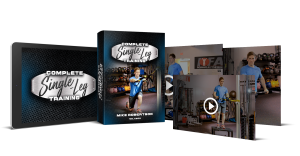
Ultimately, here’s the deal. Mike is a super smart dude. He’s always asking questions, always looking to learn, grow and improve.
I’m not a salesman; I’m a dietitian, nutrition coach and strength and conditioning coach. And I found this product to be very helpful for my own training, as well as training my own clients.
It gave me a system for using single-leg work, and if you know anything about me, you know that I find systems, processes, and concepts to be the KEYS to consistently helping folks, as well as myself. It makes it easy to know when to include single-leg work, what to include for whom, and when NOT to include it. This makes my job easier, clearer, more effective and more efficient. What coach doesn’t want that?
So, check it out. See if it’s right for you. And let me know what you think.
So yeah – the guy just might know what he
’
s doing!
Filed under: General Health, Nutrition, Training
Lots of posts about my presenting, but I seem to be doing lots of presenting this year :).
I am honored to be presenting at the largest and longest-running fitness event in the world, the 2017 IDEA® World Convention, this July in Las Vegas.
I want to share my exclusive presenter discount with you. Save up to $100 on your registration by using code WORLD17+StPierre.
Go to www.ideafit.com/world to learn more about the two presentations I am giving:
- Pre-Conference full-day workshop: Precision Nutrition Coaching Revealed
- The Cost of Getting Lean: Is it worth the tradeoff?
I hope to see you there!
Filed under: General Health, Nutrition, Training
I’m honored to be presenting at the 2017 IDEA Personal Trainer Institute in Bethesda, MD, and I want to share my exclusive presenter discount with all of you.
Get $30 OFF your full or 1-day registration by using coupon code TRAINER17+StPierre.
Go to www.ideafit.com/ptrainer to learn more.
I hope to see you there!
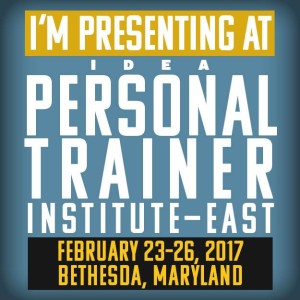
Filed under: General Health, Nutrition, Training
I’ll be doing a YouTube interview with Sam Feltham on Thursday, April 16th at 10am Eastern. If you have any questions you want me to answer, ask them right here.
Filed under: General Health, Nutrition, Training, Weight Loss
For the first time ever, Eric Cressey’s High Performance Handbook, his most popular product, is on sale. Through this Saturday at midnight, you can get this versatile exercising resource for $50 off the normal price.
As the author of the accompanying High Performance Handbook Nutrition Guide, and having worked with Eric for 3 years, I have unique insight into the quality of his training programs. Quite frankly, they are among the best in the world. And are one of only a few that I would recommend.

Eric went above and beyond to make sure that this resource covers all the bases. It’s not a one-size-fits-all cookie cutter program. Instead, it provides a quick and easy-to-apply – but incredibly effective – self-assessment component. This allows you to then go in a number of different ways with your training, depending on your goals, schedule, and assessment analysis. There’s even an entire chapter on modifying the program for special scenarios (over-40 lifters, overhead athletes, etc.). Eric covers it all.
Additionally, there is an insanely detailed video database that covers how to perform every possible exercise in the resource. It features over 200 exercises, each with a 30-120s coaching tutorial. That’s over three hours of videos that will be a useful resource long after you’ve completed the program.
As a final note, the High Performance Handbook also educates you along the way. You’ll learn about some of the things that are unique about your body, and how you need to manage your training accordingly. This will help you with your training for the rest of your life, not just the next 4+ months.
Here’s that sale link again:
–> The High Performance Handbook <–
And while your at it, be sure to consider the Gold Package, which is also $50 off the usual price. It includes my accompanying High Performance Handbook Nutrition Guide. It’s the most comprehensive compilation of every nutrition and health-related content I have ever put together. In fact, here is a recent email I received from a happy customer:
“Brian
I bought Eric’s handbook to help guide my personal training, and I think it’s excellent.
I went for the extra option and took your nutrition guide as well. Just to say I think it’s the most sensible, practical, no BS nutrition guide I’ve read. I’m in the sports nutrition industry and so read a lot of stuff, including all the extreme/quirky/plain odd dietary “theory” stuff. If everyone chose your guide, they would save themselves a lot of time, money and disappointment.
Just excellent Brian, thank you.
Stephen”
Thanks again for all of your continued support.
Filed under: General Health, Training
I just returned from providing some continuing education to high-level Equinox trainers in NYC. This is something that I do 4-6 times per year – providing 11 hours of continuing ed over the course of two days on each trip to major cities all over the US.
And it always reminds me of the power of extended presentations like that. Having continuous access to a speaker/presenter for a couple of days allows for a more intimate and effective coaching setting. As the presenter, I get to be more comfortable, and really try to teach a big-picture perspective (because I now have the time). As as attendees, the trainers get to really absorb a lot of my thoughts and experiences, and ask innumerable questions over those 2 days.
With that idea in mind, I wanted to introduce you to two world-class coaches…Joe Kenn (NFL Strength Coach) and Mike Robertson (who I have talked about many times).
A few months ago, they put on an exclusive seminar called the Elite Athletic Development Seminar. Over the course of 2 days (15 hours) they pulled back the curtain to show exactly how they write programs and coach their athletes. And much like those private Equinox talks I give, that amount of time really allows for some unbelievable material to be shared, and to really see their big-picture approach to coaching.
The seminar already happened so you can’t sign up for it now, but I wanted to let you know that they recorded that seminar and are making it available.
Elite Athletic Development
Here’s a small sampling in what’s in the course:
- Critical approach to make sure all of your programming bases are covered
- How to develop programs that address multiple physical qualities (i.e. speed, power, strength, conditioning, etc)
- Where most programs fail miserably – and what you can do to avoid it
- A “behind-the-scenes” look at real programs, designed by real coaches, No theory and conjecture here, just the good bad and the ugly behind real world programs
- A step-by-step process on how to build complex programs. Chasing one physical capacity is easy, but how do you address multiple factors without killing your athletes?
- How to organize daily and weekly training sessions for maximum success
- The evolution of Joe Kenn’s Tier System, and how he’s using it today to build elite athletes
- 6 factors for coaching success
If you’re serious about becoming the best coach possible, the Elite Athletic Development seminar is a must-have resource in your collection, so I highly recommend you check it out.
Filed under: General Health, Nutrition, Training
A few weeks ago I wrote a comprehensive article for Precision Nutrition on appropriate nutrition protocols for working out and competing in athletic events. It was incredibly well received and gave general and specific outlines on what YOU should eat around your specific training and needs. Read it here.
Now, this was like a 4,000 word article. It went into great depth, and covered a lot of ground. But I also realize that not everyone is interested in reading 4,000 words. They just want to know what to do, and how to do it. The most practical takeaways.
So with that in mind, we came up with an awesome infographic that distills those 4,000 words down into an easy to understand and apply format. Here is a small screen shot of what it looks like:
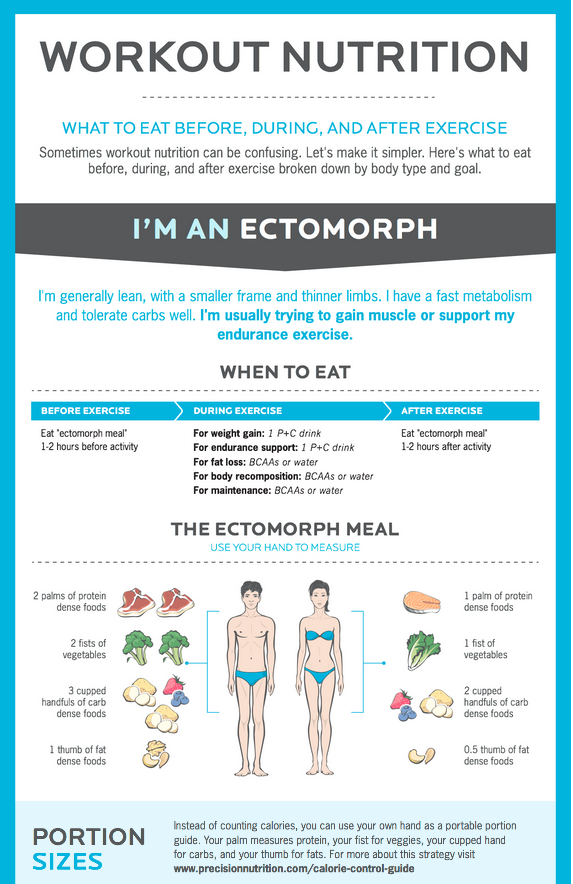
It is based both on your body type (which is a general proxy for genetics, metabolism and carb tolerance) as well as your goals (which tends to cover your activity levels). Now clearly this can’t be entirely comprehensive, but it does give you a fantastic starting point for how to eat around your training and competition to give you the best results possible.
Go here to see the full infographic.
We also provide a fully printable version of the infographic to boot!
Before I take off to Winnipeg for the weekend (I am presenting at the Canadian Athletic Therapists Association 48th National Conference), I wanted to also let you know that Mike Robertson’s fantastic Bulletproof Athlete is $50 off until midnight this Sunday.
I don’t endorse too many products, but Mike consistently puts out top-notch content, and this product is his best yet.
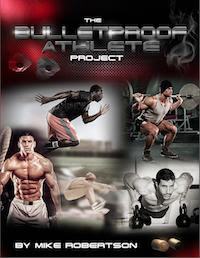
In case you’re unfamiliar with the product, here’s a brief overview of what you’ll find in the Bulletproof Athlete training system:
- 16-weeks of done-for-you training programs. Mike has written all of your workouts for the next 16-weeks. All you have to do is show up and train!
- 3 Programs for 1 Price! This is not a one-size-fits-all training program, so he created three workouts that you can choose from to determine which is best for you given your needs, goals, and time available to train.
- 160+ Exercises in the Video Database. Mike also coaches and cues every exercise in the program to make sure you’re doing things right. No guessing on how to perform movements – just follow along and you’re good to go!
- Weekly Nutrition and Recovery challenges. Every week you get a nutrition and recovery goal to help you build solid habits. After all, it’s not how hard you train, it’s how fast you recover that’s important!
Filed under: General Health, Nutrition, Training, Weight Loss, Youth Training
A few months ago I wrote a somewhat controversial article for Precision Nutrition entitled Carb controversy: Why low-carb diets have got it all wrong.
The purpose of the article was to show that people’s carbohydrate needs vary depending on several factors, most importantly your activity level.
Many took the article to be bashing a low or lower carb approach, which it really was not. The title might make it seem that way, but the piece itself made it clear that there is a time and a place for a low carb approach. It’s just not all the time, for everyone.
In fact, here is how I think people’s carb needs fall:
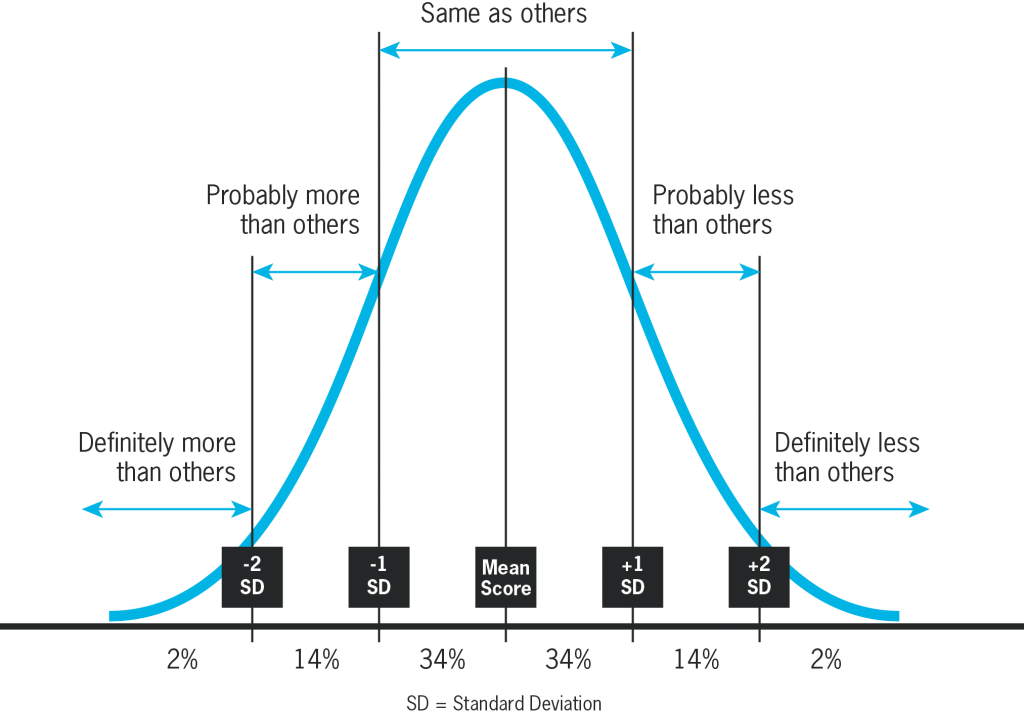
As you can see, most people would do best with a more moderate approach, as it provides:
- ample protein and fat to meet needs and prevent deficiencies;
- adequate carbohydrates to meet needs and prevent problems of inadequate intake (testosterone dropping, cortisol rising, etc); and,
- the greatest flexibility and freedom in food and meal choices, allowing for the greatest long-term consistency (the real key to sustained success).
To me, there are 3 very distinct populations that I was speaking to with this piece:
1. The general population (of which about 70% tends to be overweight).
2. The fitness crowd.
3. Insulin resistant and/or sedentary individuals.
The goals of the general population tend to be fairly modest. They often just want practical and reasonable approaches to help them find a sustainable path to their goals. The approach I provided will do just that.
The fitness crowd tends to be a little carb-shy, much to their detriment. It is something that the Paleo/Crossfit crowd has discovered. They have been recommending people up their intake of carbs lately (generally from things like sweet potatoes) as they have discovered that long-term intense training combined with a low carb diet generally does not turn out well. People in the fitness industry, or who just love fitness, should match their carb intake to their genetics, goals and activity levels. They might be surprised what they find when they do.
Insulin resistant and/or sedentary individuals would do better with a reduced carbohydrate intake. Probably in that 1 standard deviation less than the average. In this case, the average carbohydrate intake that I was advocating for was only about 40% of calories. Assuming you eat about 4 times per day, this equates to ~2 cupped handfuls of carbs for men and ~1 cupped handful of carbs for women per meal. We generally recommend that insulin resistant and/or sedentary individuals cut carbs back to about 25% of calories. This equates to ~1 cupped handful of carbs for men and ~0.5 cupped handful of carbs for women per meal. People who are insulin resistant simply do not handle carbs well. And people who are sedentary simply do not need as many since they are not as active.
To put the final nail in the coffin, here are a few studies you may find interesting.
Overfeed study of fat vs carbs. They actually found overfeeding of fat to lead to greater fat accumulation than overfeeding of carbs - http://www.ncbi.nlm.nih.gov/pubmed/7598063
Overfeeding of fat vs carbs #2. No significant differences were found between eating 1200 excess fat or carb calories - http://www.ncbi.nlm.nih.gov/pubmed/11029975
And a review study that ultimately concluded that a moderate approach is generally the best approach to start most people on - http://www.ncbi.nlm.nih.gov/pubmed/15867892
And finally, a cool new site I have come across provides some fantastic information. I have no idea whose site it is, but their take on the low carb/high fat vs. high carb/low fat debate was fantastic and thoroughly referenced - http://fitnessrealitycheck.com/2014/04/30/high-carblow-fat-vs-low-carbhigh-fat-the-debate-to-end-all-debates/
I hope that provides a little clarity on the topic for everybody.
And if you pick up a copy of my Nutrition Guide to Kevin Neeld’s new Ultimate Hockey Transformation, you will now have an even better idea of why I make the carbohydrate recommendations that I do.
In this new program Kevin provides incredible in- and off-season programs for players at the U14, U16, U18, and Junior/College levels. He also provides a comprehensive video database of every exercise in the program. Along with a great manual describing why the programs are designed the way they are and exactly how to use/adjust them based on time, space, equipment, etc. It has everything you would ever need to make yourself into the best hockey player you can be.

Filed under: General Health, Nutrition, Training, Youth Training
I had the pleasure to write the Nutrition Guide to Kevin Neeld’s new Ultimate Hockey Transformation.

Ultimate Hockey Transformation is the follow-up training program series to Ultimate Hockey Training, and features year-round hockey-specific off-ice training programs for players at the U-14 age level and above. The Ultimate Hockey Transformation system includes:
- In- and off-season training programs for players at the U-14, U-16, U-18, and Junior/College levels totaling 120 weeks of programming!
- 228 high quality videos demonstrating how to perform every exercise in the program with perfect technique
- A 65-page manual outlining everything you need to know to successfully use the Ultimate Hockey Transformation system!
- Specific warm-ups, corrective exercise, and cooldowns to help you maximize your training preparedness and recovery
- A Performance Profiling Sheet so you can track your progress over time
- The UHT Recovery Monitoring Log so you can prevent overtraining before it occurs!
Simply, following the RIGHT training program can completely alter the course of your career. Propel your game to the next level by following training programs proven to deliver game-changing results!
Simply choose the Pro Package and you also get access to my brand new Nutrition Guide, which is unlike anything I have ever written. In this Nutrition Guide I take an entirely new and improved approach for athletes to improve their nutrition and boost their health, body composition, and performance.
Check it out ===>>> Ultimate Hockey Transformation.
Filed under: General Health, Nutrition, Training
What truly sets my High Performance Handbook Nutrition Guide apart from nearly any other product is the 37 pages I devote to the Health and Lifestyle Section. We know how important proper training and nutrition are to getting the performance, health and body composition you want. However, what often goes under-appreciated are the other factors in your life that can have just as massive an impact on your results, namely: stress, sleep, and our environment.
These variables can affect every bodily system, and not taking them into account will prevent your from achieving the results you desire. Still don’t believe me? Check out these excerpts from the Health and Lifestyle Section, and see if whet’s your appetite for more!
Sleep: Why We Need It, and How To Get It
We all know that sleep is important for our health. However, many of us (if not most of us) tend to act as if that just doesn’t hold true for ourselves. We seem to believe that we can get away with it. While you may blame “work” or simply being “busy,” research clearly and consistently shows that people miss out on sleep due to something called “voluntary bedtime delay.” Basically, we stay up late because we want to, often watching “Keeping Up With the Kardashians” re-runs, or mindlessly reading useless info on Facebook. No matter the reason, it is unlikely to actually be more important than logging sufficient and quality shut-eye.
In the big picture, sleep is just as important as nutrition and exercise when it comes to improving your health, performance, and body composition.
The average adult gets about 6 hours and 40 minutes of sleep per night. In fact, about 30% of the population gets fewer than six hours per night. Women tend to sleep a bit more than men, and people who carry high amounts of body fat tend to sleep less than those with a normal body fat level. Studies suggest that people who sleep fewer than six hours per night gain almost twice as much weight over a 6-year period as people who sleep 7-8 hours per night.
Excessive sleep isn’t necessarily better, either; those who sleep more than nine hours per night have similar body composition outcomes as those who sleep less than six hours.
There is a fairly strong body of research showing that lack of sleep increases risk of many conditions, including:
- altered food intake, leading to a decrease in satiety hormones and an increase in hunger hormones, as well as an increase in pleasure response to food, causing increased food intake
- altered glucose tolerance, insulin resistance & diabetes
- inflammation
- obesity
- disruption of cortisol levels and rhythm
- decrease in testosterone and increase in estrogen
- loss of lean mass, including muscle, bone and organs (such as your brain)
- decrease in thyroid stimulating hormone
- heart attack
- stroke
It is important to note that sleep debt is cumulative, meaning that the more nights with less sleep, the greater likelihood of negative effects taking place. The good news is that you can catch up with just a few consecutive nights of adequate sleep. Experts hypothesize that each hour of sleep debt needs to be repaid eventually, so don’t let it add up.
Okay, so we know lack of sleep is a problem. As researchers have noted regarding sleep debt: “these alterations are similar to those observed during aging and sometimes during depression.” Awesome.
Fortunately, research also shows that simply getting adequate sleep can quickly right the ship on these issues. So, how do we go about creating an environment conducive to optimal sleep? Well, here is a step-by-step guide on getting sufficient, and restorative, sleep.

Environmental Carcinogens
Hundreds of chemicals are capable of inducing cancer in humans or animals after prolonged or excessive exposure. Chemically-induced cancer generally develops many years after exposure to a toxic agent. For example, a latency period of as much as thirty years has been observed between exposure to asbestos and incidence of lung cancer.
In 2010, the President’s Cancer Panel Report declared that “The true burden of environmentally induced cancers has been grossly underestimated…this group of carcinogens has not been addressed adequately by the National Cancer Program. The American people – even before they are born – are bombarded continually with myriad combinations of these dangerous exposures.”
According to the report, there are about 80,000 chemicals in commercial use in the United States, but only about 2% of those have been assessed for their safety. The report singles out radon, formaldehyde, and benzene as major environmental toxins that are causing cancer.
Radon: What is it, Where is it, and How do I Get Less of it?
Radon is a colorless, odorless, radioactive gas. It comes from the natural decay of uranium or thorium found in nearly all soils, and it typically moves up through the ground and into the home through cracks in floors, walls, and foundations. It can also be released from building materials or from well water. Radon breaks down quickly, giving off radioactive particles. Long-term exposure to these particles can lead to lung cancer.
The U.S. Environmental Protection Agency estimates that radon causes about 21,000 lung cancer deaths in the United States each year, with 1 in 20 U.S. homes having elevated levels. Radon exposure is the second leading cause of lung cancer after smoking, and the leading cause among non-smokers.
Testing for radon and taking the necessary steps to lower radon levels in homes that have elevated radon can prevent many radon-related lung cancer deaths. This process is known as radon mitigation. Getting your home air and water (if you are on a well) checked is simple and inexpensive – and can save your life and the lives of your loved ones.
Formaldehyde: What is it, Where is it, and How do I Get Less of it?
Formaldehyde is a colorless, flammable, strong-smelling chemical that is used in building materials and to produce many household products. It also occurs naturally in the environment and is produced in small amounts by most living organisms as part of normal metabolic processes. Formaldehyde has been classified as a known human carcinogen by several government agencies.
Formaldehyde sources in the home include pressed-wood products such as particleboard and plywood, glues and adhesives, permanent press fabrics, cigarette smoke, and fuel-burning appliances. In addition, formaldehyde is commonly used as an industrial fungicide, germicide, and disinfectant, and as a preservative in mortuaries and medical laboratories.
Research studies of workers exposed to formaldehyde have suggested an association between formaldehyde exposure and several cancers, including nasopharyngeal cancer and leukemia. Rats exposed to formaldehyde fumes developed nasal cancer.
The EPA recommends the use of “exterior-grade” pressed-wood products to limit formaldehyde exposure in the home. Ensuring adequate ventilation, moderate temperatures, appropriate humidity levels (through the use of air conditioners and dehumidifiers), and the use of indoor plants can also reduce formaldehyde levels in homes.
Benzene: What is it, Where is it, and How do I Get Less of it?
Benzene is a colorless liquid that evaporates quickly. It is naturally found in crude oil and is a basic petrochemical. Unfortunately, it is also a known human carcinogen. Benzene is found in tobacco smoke, gasoline (and therefore car exhaust), pesticides, synthetic fibers, plastics, inks, oils, and detergents. Benzene has also been found in soft drinks (since removed or reformulated), and dryer emissions from scented laundry detergent and dryer sheets.
About 50% of the benzene exposure in the US results from smoking tobacco or from second-hand smoke. Substantial amounts of data link benzene to aplastic anemia, bone marrow abnormalities and leukemia – particularly acute myeloid leukemia (AML) and acute non-lymphocytic leukemia (ANLL).
To decrease benzene exposure, don’t smoke, and try to avoid second hand smoke. Ensure adequate ventilation in your home, use non-scented laundry detergents and dryer sheets, and keep plants in the home.

Household Cleaning and Personal Care Products
Cleaning supplies come in all shapes and sizes, with an infinite amount of marketing and advertising to promote them. It is hard, if not downright impossible, to know today what you really need to clean your home. Which chemicals may do more harm than good? Which companies are actually trying to marry safety and effectiveness, not just worrying about their bottom line and shareholder profits?
In addition, personal care products and cosmetics are also ubiquitous in society today. We all use them to look better, smell better, and feel better about our presentation to the world.
Unfortunately, many of these products are known contributors to poor air quality and various other health problems. Many ingredients in personal care and household cleaning products are known to harm or irritate the lungs and trigger asthma, even in healthy people. Some products even contain ingredients that are known endocrine disruptors and are linked to cancer and reproductive abnormalities. They also pose a great threat to aquatic life as they eventually end up in waterways.
You can forget trying to read the labels to discern their safety, though. Not only do labels require a PhD in advanced chemistry, but federal law in the U.S. allows companies to leave many chemicals off labels. These acceptable omissions include nano-materials, ingredients considered trade secrets, and the ingredients of “fragrance.” Instead, they use of terms like “cleaning agent” or “quaternary ammonium compound” for anything they decide they don’t want to list.
Your best bet is to check for warnings and the ingredients I will cover next. Don’t be fooled by marketing claims.
You might think that this is a hyperbole or tree-hugging paranoia and that your government would not allow such dangerous chemicals to be so widely used, and to not require them to be listed. You would be wrong.
In the U.S., companies that make cleaning or personal care products may use nearly any ingredient or raw material in their product formulations without government review or approval. They are not required to disclose all of their ingredients on the label. The Toxic Substances Control Act of 1976 laid out what the EPA could do to regulate the industry: essentially, not much.
If a product or chemical is deemed to pose an unreasonable risk of injury, companies can voluntarily recall a product. These recalls tend to focus on immediate injury risk such as chemical burns or fire hazards, not subtle problems with chronic implications, such as asthma or cancer. Companies do not have to prove chemicals are safe before putting them into cleaning products. In fact, in its more than 30-year history, the Cosmetic Ingredient Review (the cosmetic industry’s safety panel) has assessed fewer than 20% of cosmetics ingredients and found only 11 ingredients or chemical groups to be unsafe.
The chemical industry as a whole is largely unregulated. There are over 80,000 chemicals in use in the U.S., and the vast majority have never been assessed for safety by federal regulators.
“There are too many chemicals and not enough data,” said Kevin Crofton, EPA research toxicologist. “There are literally thousands and thousands of chemicals in use for which we really don’t have much information at all.”
In addition the terms “hypoallergenic” or “gentle” do not necessarily indicate a product is safer, or is even those things. A company can use a claim like “hypoallergenic” to mean anything, or nothing at all. Remarkably, the Environmental Working Group conducted an assessment of over 1,700 body care products and found that 81% of those marked “hypoallergenic” or “gentle” contained allergens or skin and eye irritants!
In the U.S., there are more than 500 products sold that contain ingredients banned in cosmetics in Japan, Canada, or the European Union. The FDA also has little authority over cosmetic companies, cannot recall harmful cosmetics, and relies on companies to report injuries from their products a voluntary basis.
—————————————————-
Pick up your copy of The High Performance Handbook today before the introductory price expires Saturday at midnight!
To sweeten the deal, Eric has decided that everyone who purchases a copy (and who has purchased already) will automatically be entered to win one of these prizes:
1. ANOTHER all-expenses-paid trip to get evaluated and train at Cressey Performance. Again, Eric will cover all your travel and accomodations expenses, and the training will be on the house.
2. One of three free copies of his “Art of the Deload” e-Book.
3. One of three free online accesses to Mike Reinold and Eric’s new “Functional Stability Training of the Lower Body” online resource!
There are only 36 hours left, so don’t miss out!













Posted on September 22nd, 2017 by Brian St. Pierre
2 Comments »